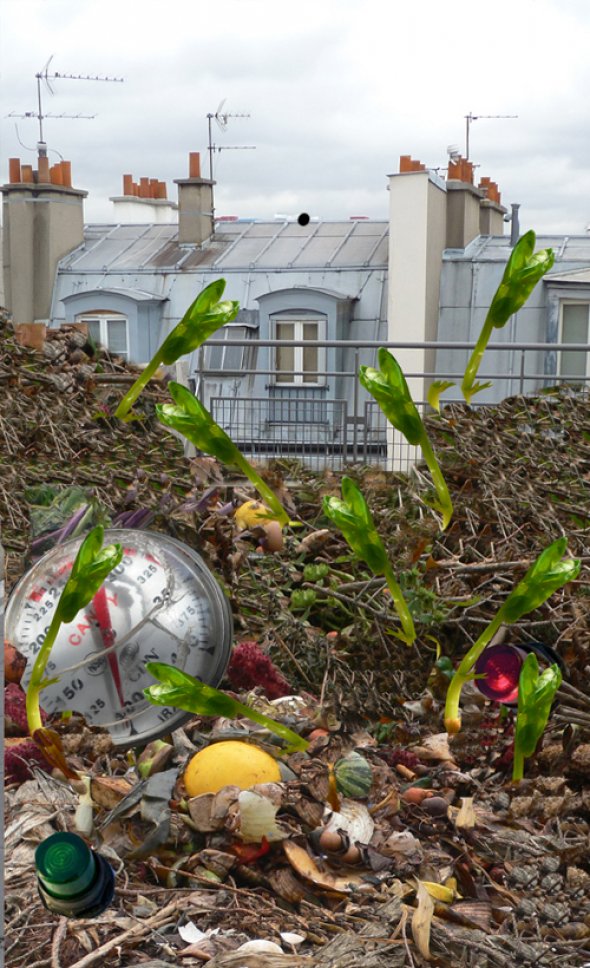Compost Your Orgasm Trash
Bread soup that sprouts trees, redundant sex replicants gone feral and art publics harnessed to sort e-trash – artist and film director Shu Lea Cheang’s work knows no bounds. In conversation with Matthew Fuller, she discusses the polymorphous pleasure of jamming social, technical and organic circuits
Matthew Fuller: So I guess what I’m interested in doing is running a few lines through your body of work over several years, or decades in fact, to think about how the relations between technology, everyday life, different kinds of practices – food, organisation, science fiction, different kinds of queer sensibilities – are mixed together in various ways to produce different projects. One of the key things that is intriguing about so many of your projects is that you have a way of making propositions about a different reality. So using science fiction- or currency-tropes, you’re always either suggesting that these futures are happening already or that there is something else that can be added to contemporary reality. What what is that kind of approach, adding something...
Shu Lea Cheang: It’s actually becoming a bit of a myth or fable or burden for me in a certain way. At this moment, I am in a creative mode, still I have many unrealised concept and projects. I seem to always be getting my hands into several projects, and I just keep going. In terms of traversing different practices, different fields, I always like to have a big project that I can organise with other people, at the same time as having a few smaller scale pet projects to entertain myself.
MF: So at the moment you’d have Composting the Net?
SLC: Yes I’m hoping to connect Composting the Net with Composting the City. Of course the compost is not something new, but consider the scale of the City, the Net, it’s exciting for me. I am interested in researching an urban ecosystem, a human-based ecosystem that can run parallel with Composting the Net. This idea came up recently, I have a few cities in mind in which I could realise this project: Paris, Berlin, Amsterdam. I am considering working with local restaurants, the bread, veggie shops, scrapping their left-overs of the day. In Paris, they’re not allowed to sell or give away old bread. This really amazes me – usually I would think ‘why don’t you just give it to the homeless people who are right outside your shop?’ They said ‘no we can’t do that.’ I said, ‘how about you give it to me, I can make a bread soup?’, they said ‘no we can’t do that.’ So I wonder if I can organise a kind of compost dump system and collect it so the compost will become a new part of the soup, a tree growing soup pot. There is surely a more scientific/industrial approach to organize urban compost, but I’m taking up a human/social perspective.
MF: So who are you collaborating with for this?
SLC: I am quite involved with Refarm the City, which originated in Barcelona with a focus on urban farming and eco-technology. We have a residency in Paris scheduled for May. I think I can make some urban composting experiments.
MF: What would be the plan?
SLC: I think I would have to go out and collect from shops, but also organise drop-offs. Before I got into compost, I was dealing with e-trash over the last three years. It’s a kind of natural progression, to bring back data trash and food waste as biodegradable. In Paris, I may be able to organise it with a residency at La Gaîté Lyrique, Les Halles a new digital art space. With many restaurants in the area – Centre Pompidou, Arts et Metiér, Les Halles – I can try to create a milk churn system: you leave it and I come and collect it the next day. I like this idea of physical contact, cycling the waste around town.
MF: What does compost mean to you as a cultural project? Is it at the chemical level, the social level, the ecological level? Where’s the twist? Why is it you doing it and not the local council?
SLC: For me its mostly on the social level. I am wary about the recycling business. I want to do something with direct recycling, if there is a recycle loop, let me see how this loop is wound up; same thing with the e-trash business. Why are we shipping it to developing countries like Africa and China for the workers to go through the shit and pick out what they can sell, and then just burn the rest and pollute the air? I am interested in how this cycle could work locally.
MF: To make the cycle tighter? Such cycles become a medium to work in.
SLC: Yes. I like to consider the cycle as a medium. Another project called cycleX, we are trying to get it started in Andes, New York State. The cycle as a season, seasons cycle.
MF: So you have this mode of making a system of compost, getting a tighter cycle between waste generation and its reinsertion into ecological cycles, but you also want to make each step of that cycle visible and understandable. And it seems also with your wireless project there’s a similar way in which you make the process of circulating signals visible, and also much more deeply embedded in person to person transactions so it is tighter but also you make it erotic, you make it science fictional, futuristic and that’s quite different to the compost stuff. There’s no sexy compost. Yet...
SLC: Vermicomposting is one of the basic composting methods. With worms in action, decadently sexy…There are, however, some design issues with high end and low end composting we need to consider.
MF: What are they?
SLC: High end composting, in scientific terms, involves building up a large scale decaying system. The low end composting would be – give it to the pig, in the countryside. But in the city, what would that pig be? Or what can be a self-manageable composting system? All in all, the composting project, the cycleX, and Green Rush (a project sharing food talking series I started in Paris in 2010), all serve as public platforms for green issues.
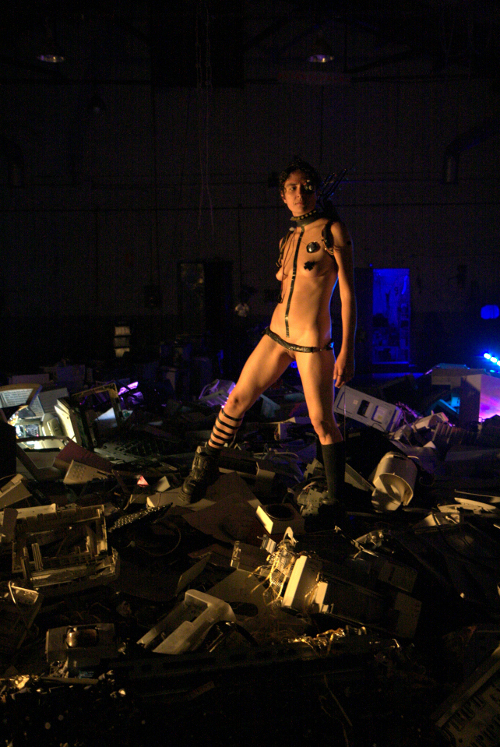
Image: Shu Lea Cheang,U.K.I., agent pony boy, hangarBCN, 2009. Photo: Rocio Campana
MF: So the person making these compost projects is also making I.K.U. I’m interested in the compost in the aesthetic of these projects. What is the line of affinity between that and a science fiction porn movie?
SLC: The sci fi porn movie I.K.U actually has just been cycled. I.K.U was released in 2000 and I just released its sequel UKI. I don't know if I am stretching myself to connect all these concepts together. Maybe I am a split personality artist? Or somehow there's affinity as you are suggesting?
MF: What is UKI?
SLC: UKI was first conceived as a sequel to I.K.U. for the Japanese producer, Uplink.co, but never got developed. With an artist residency in Hangar Barcelona in 2009, I ended up developing UKI as a viral (cinema) performance and a viral game. UKI also grew out of my involvement with Post-Porn communities.
MF: Specifically in Paris?
SLC: Actually there’s a curator I work with, Beatriz Preciado, a queer theorist. Her recent book is Testo Junkie: Sex, Drugs, and Biopolitics. UKI as viral performance was part of her show La internacional cuir at Museo Centro de Arte Reina Sofía in 2011. With her, I got connected with Barcelona's queer post-porn performers who I subsequently collaborated with in creating UKI performance. I am also grateful to Pedro Soler, then the director of Hangar Barcelona, who accepts my radical mix of open source software and sci fi sex fiction.
The title UKI, as a reverse of I.K.U., came up easily. But exactly what it would be about took me a while to work out. Set in an e-trashscape, the post-(net) crash scenario is much in sync with my other media art projects, like TAKE2030. I should also emphasise my interest in merging software and body viruses. In this respect, Jussi Parikka's book Digital Contagion and your interview with him informed me a great deal. I.K.U. was a take-off of Blade Runner, originated from a simple question, 'do the replicants have sex?'. In UKI, I question ‘where do the redundant sex replicants go?’ The first part of UKI is a viral performance – live code, live spam. Dumped amidst e-trash, where DIY open hardware builders and die-hard free networkers co-exist, data-deprived replicants trade sex for codes, code sexing code, ultimately UKI as a virus emerges.
MF: What is the second part?
SLC: The scenario follows the UKI virus taking up with the big evil corporation GENOM, who relocates its operation inside the human body, building up BioNet with microcomputing blood cells. For this part I am also indebted to the science fiction novel Blood Music by Greg Bear. While GENOM attempts to reconfigure self-sustainable organismo, UKI infects and propagates, mobilises the viral force to infitrate the BioNet, to reclaim the human orgasm. This viral game part is made up in two levels: Infect the City (level one) with geolocation, smartphone application, and Enter the BioNet (level two) with biosensors and subwoofers. The development was made with residencies at medialab Prado (Madrid) and Plataforma Cero, LABoral Centro de Arte y Creación Industrial (Gijón, Spain). The biosensor part of the game works with GSR (Galvanic Skin Response) sensors with which we are developing a collective shooter game... mostly working with emotional response and social interaction among the gamers, the virus. Even with the technology and programming developed, it is still hard to find a showcase to realise the project in total. Maybe at some point, I will need to re-adapt it back to a feature film!!
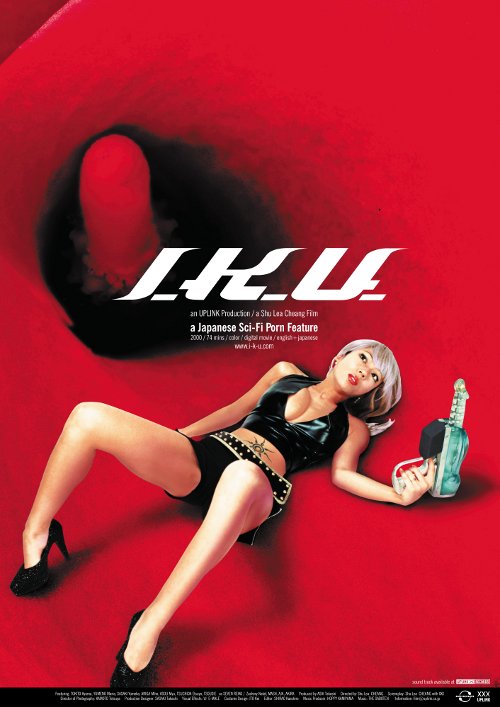
Image: I.K.U. movie poster, 2000, Uplink Co., Tokyo, Japan
MF: A lot of your projects have no end, they’re kind of like machines that produce sets of relations, that produce scenarios, that produce films, that produce orgasms, that produce encounters between people, that produce encounters between technologies and situations, and they keep unfolding. It’s interesting in relation to art which traditionally had a stable delineation as an object, the status of the object is very different to the machines of experience you set in play. I wonder what drives you to that, what version of art do you imagine your work corresponding to?
SLC: Although I would avoid using this term ‘life art’, in the end, I am living the art, or should I say, art is living me? A lot of time people do get confused: this woman making sci fi porn is also a political activist? For me it’s a requirement, I confess my sexual desire, I accept what I eat what I fuck as life cycle. In that sense there is no ending. A work can be converted into different forms, expressions, mediums, locations, technologies. The work itself is a process of mutation... I don’t see how I’m going to end it. But I’m arriving at a point, I need to pursue the occasions to realise some early concepts, (aya!, hopefully it's not dated)... like a feature film concept FLUID, which I wrote for Lars Von Trier's Zentropa whose Puzzy Power division would have made the film but they went bankrupt.
MF: Is a project a form of delineating a period of life, a passage of time, of people, of experiences, of objects, of stories? But then you also make very precise interventions like the garlic currencies that are very tightly focused. You have a proposition, you create a system which you put into play, you draw people in, it operates for a specific period of time, it allows people to re-imagine economic relations, relations to plant materials, relations to food, relations to value and so on. It’s both very sensual, simple and very complex. It’s a very different modality in which your work operates as well, it’s a very clear, abrupt imaginative humorous proposition.
SLC: The garlic project isn't going to die. At a different point in time, it can be realised again, you can take the concept and work with different economic situations and various cities. Agliomania has been realised in Naples (2008), Novi Sad (2009) and Bristol (2010). Taking garlic as trading power reinvents the classic tale of Tulipomania, which remains the case study for bubble (literally) economies. I cannot or I don’t want to set an end date for it. Unlike my other work, BRANDON, a Guggenheim museum commission during institutionalised net art's early days, is clearly marked as a one year (1998-1999) web narrative. It did take me the one year cycle to explore gender politics and cyber crimes with quite a few institutions and artists involved.
MF: Let’s move on to the question of duration. What does that mean in your work? Amongst your projects you often draw in the undergoing of experiences of a day or a month or 12 hours that involve different aspects of life like eating, sleeping, physical exercise, kung fu, moving around the city, thinking, talking, making art, technology; all of these things overlap with each other, arise out of one another, but also have a particular kind of attention paid to them, partly from the story you're telling and partly through the imaginary grammar that you set up between entities in these projects. Duration is the thing that allows things to hang together in a certain way.
SLC: I first learnt about durational art in video art practice, set up a loop to repeat the video clip... It frees us from the feature’s set duration in the movie house. I have taken the durational concept and expanded it as durational narratives and distributed space. This kind of work requires collaboration and public participation, intervention. It is like I have written a concept, a scenario and I need the parts (the agents, the techniques) to run the scripts together. For feature films – I made two, Fresh Kill (1994) and I.K.U. (2000) – I would need to write a script before gathering the parts (actors) together. For the durational networked performance works, I bypass the lonely scripting self, allowing the scripting to be openly conducted as a public forum... also to take in elments of the unexpected, as life’s routines.... You just need the timeframes – for me it’s a liberation of an art form.
MF: Liberation of an art form from what?
SLC: Lots of things. I was suffering a lot from censorship even in the ’90s. With my first networked installation Bowling Alley (1995), I was asked to review all the incoming texts which were set up with machine-read only scramble codes... I was required to delete texts containing the F word. For KOP (Kingdom of Piracy), a net-based project I co-curated with Yukiko Shikata and Armin Medosch, we were asked to delete one artist's web link to a Palestinian resistance site by our commissioner ADAC (Acer Digital Art Center) back in 2002... With the living processing durational work, I am selling a concept, a scenario and a troupe of players... I do not submit a script to be consented to. There are also budget issues, we basically cut off rehearsing and post-production expenses. In today's terms, we will be ‘crowd sourcing’, as in the case with Moving Forest’s London launch in 2012.
MF: You use this word scenario. What role does the scenario play?
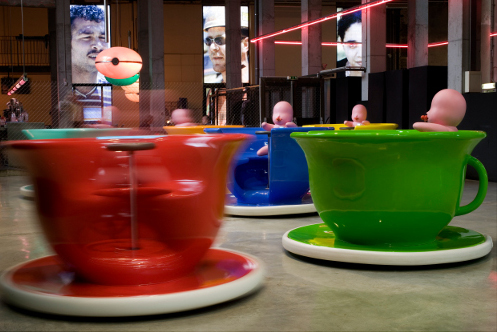
Image: Shu Lea Cheang, Babylove, Palais de Tokyo, 2005. Photo: Florian Kleinefenn
SLC: I have a cinema studies background, a pre-script scenario conveys the concept and anticipates the dialogue form of a script. The scenario, used in the networked performance arena, positions the key players and maps the programming. While codes can be written, they can also be hacked. The scenario brings in the ingredients of a soup pot, the recipe varies... the scenario, unlike the manifesto, does not declare or set up doctrines. In my case, I prefer making up sci fi scenario which push for further imagination.
MF: The scenario is the thing that allows people to organise around the concept and generates the grounds for collaboration, but is also a more open form of collaboration in which multiple kinds of events and processes are joined together in a framework. What about a project like Baby Love? One which has a scenario, which is also something from the world of 2030 in a sense, but is a sculptural object that people enter into that’s very fantastic, with a strong science fictional element but also a twisting of the use of technology, particularly the circulation of MP3s, and the use of wireless in which this tech is imagined otherwise. It’s partly in the scenario, but also in the function of the objects, how people inhabit the objects. How does the creation of this particular type of object create the kinds of open conditions or framework you’re interested in? Can an object have the same function as a scenario? How is it different?
SLC: Baby Love is the second part of the Locker Baby project which was conceived in 2001 at a time when the exposé of clone technology was stirring the imagination. I was living in Tokyo when Aum Shinrikyo's sarin gas attacked Tokyo subways. There were reports that coin lockers were used for depositing sarin packs. The terrorists' connection has meant many countries have eliminated the installation of coin lockers in airports and in subways. I am always quite alarmed about the orderly placement of coin lockers, I fear for its potential exposé, explosions. As in Ryu Murakami’s Coin Locker Babies, a book in which two brothers are abandoned in coin lockers by an unwed mother in post-war Japan and grow up to have their mother’s heartbeat haunting them... like a time bomb ticking...
So, the scenario! For the Locker Baby Project, Dolly Polly Transgency (DPT) extracts genes from deep sea pearls collected by Ama hunters off Okinawa island and produces its test tube clone babies in coin lockers. The clone babies are entrusted to retrieve our collective deposits of ME (memory – emotion) data. Pretty wild?!! I love evil corporations! The Locker Baby Project was conceived in 3 parts that includes Baby Play (realised in Tokyo's NTT[ICC] in 2001), Baby Love, (realised at Paris' Palais de Tokyo in 2005) and finally this year I can realise Baby Work with (possibly) a joint commission from Inspace, University of Edinburgh and Zero1 in San Jose, California.
I need the Baby as tangible object to trigger a public interface. Mostly I want this series to be playful, publicly accessible (terms to be defined!) work. Well, the objects are also a medium, in my case, no high-end robotic production involved, but simply interlinks connecting humans to the hidden ME... ME as data. I guess ‘objects’ need to be defined, while ‘scenario’ remains fluid?
MF: What is Baby Work?
SLC: When I first conceived the Locker Baby Project in 2001, I tried to bring back the typewriters. The keys that hold the (un)written.
As I only get to realise Baby Work in 2012, I think it's time to say goodbye to the keyboard era as we enter the touch/feel screen interface era. For Baby Work, I dare to propose ‘You are the Baby, Work!!’ recalling the electronic assembly workers along the conveyor belts, the labour force of children surfing the valuable electronic bits buried under the e-trash mountains. I want the gallery public to actively participate in the production line and recycling business.
Baby Work, as performance/installation, is introduced by an opening Public Act of defunct robots trashing the junked keyboards and an intelligent mural made out of stripped keyboards, the metal plates and the PCBs uncovered. The gallery viewers, the public, walk through the trash piles, picking up keys to place them on the metal plates. Each placement of a key triggers ME.. This time, I think I am mostly using jingles of the mobile era. I am still in the development stage for this work, actually. I expect people would either try to reassemble a keyboard or place keys like in a scrabble game... the sound note output should be annoying enough!!
MF: And the room would have the robot smashing things up...?
SLC: No, no, only for the opening night or at scheduled times. I cannot handle public safety issues... The robot – well hopefully I can revive one from the robot cemetery in the university labs... add some grabbing machine arms and leave it for playland...
MF: Another cycle is proposed between waste, dead robots, reconstitution of e-waste and a new functionality. Again you are not simply making a cycle tighter and more concrete and visible but proposing a new cycle. As with CycleX, your open call for projects on the farm.
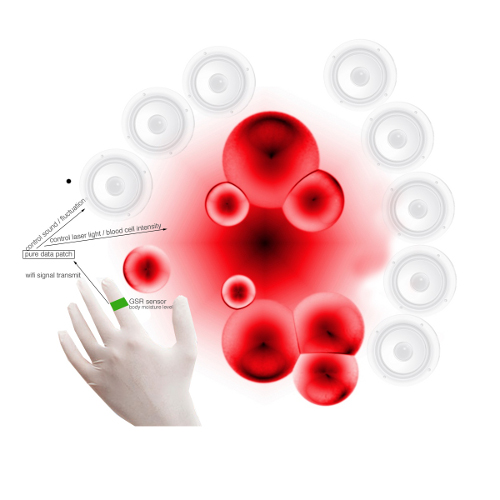
Image: Shu Lea Cheang, sketch for U.K.I. Game Bionet, 2011
SLC: Yes, CycleX, invites you to ‘make art make farm’ for a six month cycle. It is grounded at a piece of farm land I accidentally (long story for this one, we’d need a bottle of red wine to go with it!!) acquired in Andes, New York. Launching cycle one this April with the Dat Green team from Philadelphia, sisters with a holistic interdisciplinary sensibility... I am quite excited about this land use of an undefined nature. There is a great farmer, Tovey Halleck, who connects to this project. Tovey is an artist, welder, farmer, for whom I created the Garlic=Rich Air project with Creative Time in New York in 2002... Gee, you could never fail with garlic growing, calculate the multiplication year by year... Here is a scheme to get rich, durationally.....
Matthew Fuller is author of Elephant & Castle, Autonomedia, 2011,
Info
Further information on Shu Lea Cheang's work can be found at:
http://www.mauvaiscontact.info/
Shu Lea Cheang's project UKI will be showcased, among other virtual worlds, web and robotics pieces, in the coming exhbition, Robots and Avatars, at FACT, Liverpool from 16 March to 27 May 2012. Read more about UKI in the exhibition: http://www.robotsandavatars.net/exhibition/exhibits/uki/. Read more about the exhibition: http://www.robotsandavatars.net
Mute Books Orders
For Mute Books distribution contact Anagram Books
contact@anagrambooks.com
For online purchases visit anagrambooks.com

